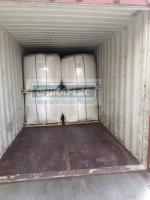Our Products
Polyacrylamide / Equivalent model of Rheomax DR 1050 can be replaced by Chinafloc A series


Equivalent model of Rheomax DR 1050 can be replaced by Chinafloc A series
Rheomax DR 1050 is a kind of anionic polyacrylamide with AMPS monomer mainly used for mineral processing ,water treatment and other applicaitons.Chinafloc A0109 can replace of it with good performance.
The main application of anionic polyacrylamide with AMPS (2-acrylamido-2-methylpropanesulfonic acid) monomer is in the field of water and wastewater treatment. Anionic polyacrylamide with AMPS monomer, also known
as AMPS polymer, is used as a flocculant and coagulant aid in various water and wastewater treatment processes. Some specific applications
include:
Coagulation and Flocculation: AMPS-based anionic polyacrylamides are used to improve the coagulation and flocculation processes in water treatment. They help particles and impurities
in water to aggregate and settle out more effectively, aiding in the removal of suspended solids and turbidity.
Sludge Dewatering: These polymers are employed in sludge dewatering processes to enhance the separation of water from sludge, reducing the
volume of sludge for disposal.
Wastewater Treatment: Anionic polyacrylamide with AMPS monomer is used in wastewater treatment plants to improve the efficiency of various
treatment steps, including sedimentation, filtration, and clarification.
Enhanced Oil Recovery (EOR): In the oil and gas industry, AMPS-based anionic polyacrylamides can be used in enhanced oil recovery processes to improve the displacement of oil from reservoirs.
Soil Erosion Control: These polymers can be applied to control soil erosion in construction and agriculture by stabilizing soil particles and preventing
their displacement by water.
Paper and Pulp Industry: They are used as retention aids and drainage aids in the paper and pulp industry to improve paper quality and reduce water
usage.
Mining and Mineral Processing: Anionic polyacrylamides with AMPS monomer are utilized in mineral processing to aid in solid-liquid separation, as well as in tailings and slurry treatment.
Textile Industry: They can be used in the textile industry for wastewater treatment and color removal processes.
In summary, anionic polyacrylamide with AMPS monomer finds its primary application in improving the efficiency of water and wastewater treatment
processes by aiding in the coagulation, flocculation, and solid-liquid separation steps. Its versatility and effectiveness in these applications make it a valuable chemical in various industries related to water and
environmental treatment.
AMPS (2-acrylamido-2-methylpropanesulfonic acid) is a functional monomer that can be incorporated into polymer structures to provide specific properties and functions.
The function of AMPS in a polymer can vary depending on the specific application and the polymer matrix in which it is used. Here are some
common functions of AMPS in polymers:
Ion Exchange: AMPS-containing polymers can provide ion exchange properties due to the presence of sulfonic acid groups. This makes them useful in applications
where ion removal or selective ion exchange is required, such as in water softening or desalination processes.
Hydration and Swelling: AMPS polymers have high water-absorbing and swelling capabilities. This property is beneficial in applications like superabsorbent materials, such as those used in diapers or
agriculture for water retention in soil.
Charge Density: AMPS polymers can impart a negative charge to the polymer structure, making them useful in flocculation and coagulation
processes for water and wastewater treatment. This negative charge can help in the aggregation and removal of suspended particles.
Thermal Stability: In some cases, AMPS can enhance the thermal stability of the polymer, making it suitable for applications where high-temperature resistance is required.
Improved Solubility: AMPS can improve the solubility of the polymer in water, which is advantageous in various applications, including water
treatment and dispersant formulations.
Enhanced Rheological Properties: AMPS-containing polymers can modify the rheological properties of a formulation, making them suitable for applications where thickening, stabilizing,
or controlling the flow behavior of a liquid is important.
Controlled Release: In the pharmaceutical and agricultural industries, AMPS-based polymers can be used for controlled drug or nutrient release applications. The polymers can be designed to release their contents gradually
over time.
Oil Recovery: In the oil and gas industry, AMPS-based polymers are used for enhanced oil recovery (EOR) processes, where they can modify the rheology of injection fluids to improve oil displacement
from reservoirs.


